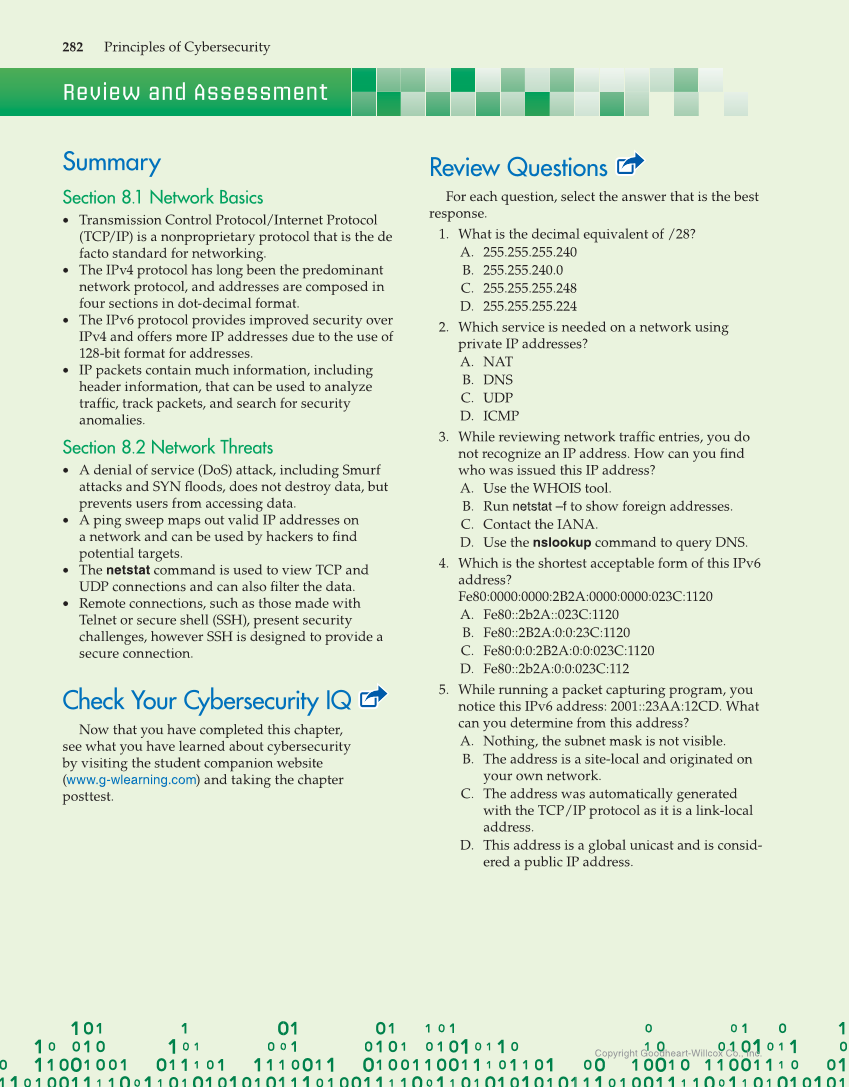Review and Assessment Copyright Goodheart-Willcox Co., Inc. 282 Principles of Cybersecurity Summary Section 8.1 Network Basics • Transmission Control Protocol/Internet Protocol (TCP/IP) is a nonproprietary protocol that is the de facto standard for networking. • The IPv4 protocol has long been the predominant network protocol, and addresses are composed in four sections in dot-decimal format. • The IPv6 protocol provides improved security over IPv4 and offers more IP addresses due to the use of 128-bit format for addresses. • IP packets contain much information, including header information, that can be used to analyze traffi c, track packets, and search for security anomalies. Section 8.2 Network Threats • A denial of service (DoS) attack, including Smurf attacks and SYN fl oods, does not destroy data, but prevents users from accessing data. • A ping sweep maps out valid IP addresses on a network and can be used by hackers to fi nd potential targets. • The netstat command is used to view TCP and UDP connections and can also fi lter the data. • Remote connections, such as those made with Telnet or secure shell (SSH), present security challenges, however SSH is designed to provide a secure connection. Check Your Cybersecurity IQ Now that you have completed this chapter, see what you have learned about cybersecurity by visiting the student companion website (www.g-wlearning.com) and taking the chapter posttest. Review Questions For each question, select the answer that is the best response. 1. What is the decimal equivalent of /28? A. 255.255.255.240 B. 255.255.240.0 C. 255.255.255.248 D. 255.255.255.224 2. Which service is needed on a network using private IP addresses? A. NAT B. DNS C. UDP D. ICMP 3. While reviewing network traffi c entries, you do not recognize an IP address. How can you fi nd who was issued this IP address? A. Use the WHOIS tool. B. Run netstat –f to show foreign addresses. C. Contact the IANA. D. Use the nslookup command to query DNS. 4. Which is the shortest acceptable form of this IPv6 address? Fe80:0000:0000:2B2A:0000:0000:023C:1120 A. Fe80::2b2A::023C:1120 B. Fe80::2B2A:0:0:23C:1120 C. Fe80:0:0:2B2A:0:0:023C:1120 D. Fe80::2b2A:0:0:023C:112 5. While running a packet capturing program, you notice this IPv6 address: 2001::23AA:12CD. What can you determine from this address? A. Nothing, the subnet mask is not visible. B. The address is a site-local and originated on your own network. C. The address was automatically generated with the TCP/IP protocol as it is a link-local address. D. This address is a global unicast and is consid- ered a public IP address.
